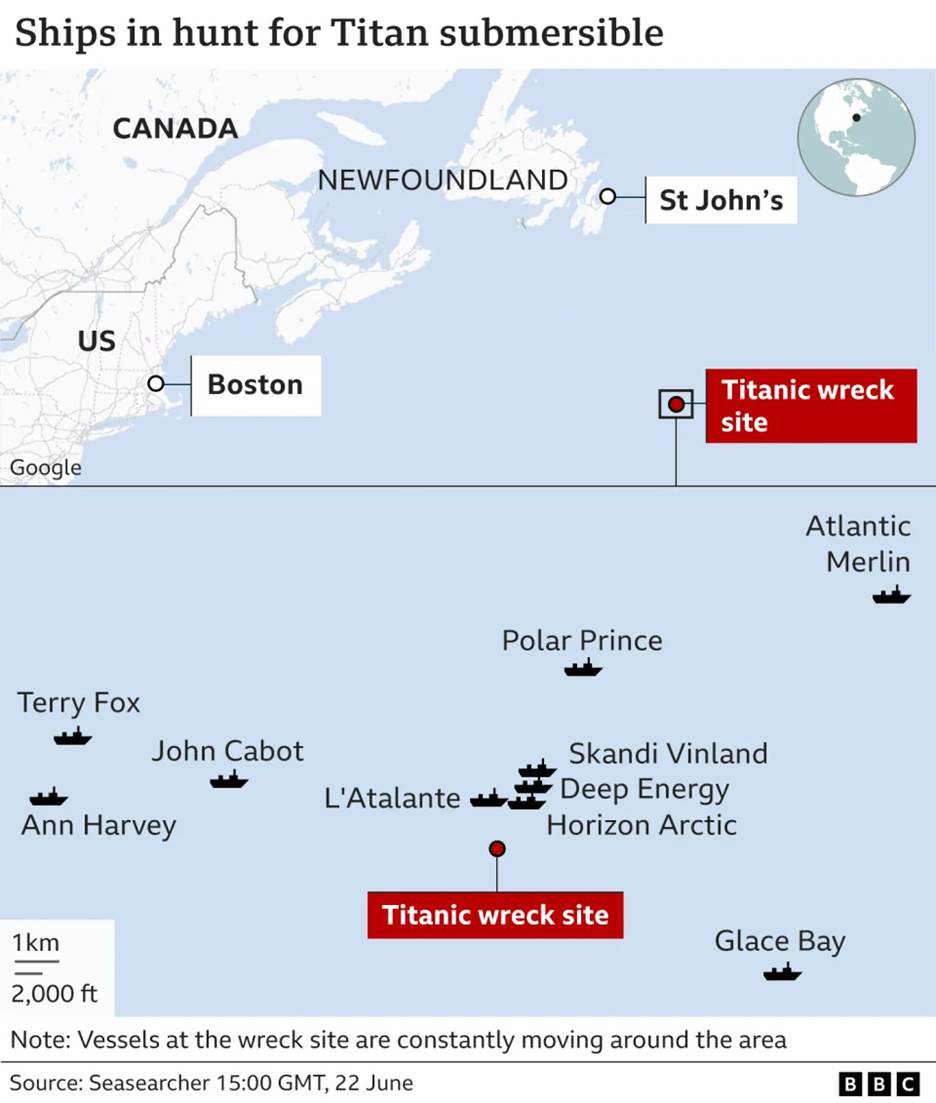
Map showing location of the Titanic wreck site in relation to Newfoundland and St John's and some of the ships used in the search
Titan Sub Implosion: What We Know about the Catastrophic Event
US authorities say a debris field located in the North Atlantic leads to a conclusion that OceanGate's Titan submersible suffered a "catastrophic implosion" (a violent collapse inwards), instantly killing all five passengers on board.
The US Navy says it detected sounds "consistent with an implosion" shortly after the sub lost contact on Sunday during a descent to the Titanic wreck at 3,800m (12,467ft) below sea level - but this information was only made public on Thursday.
The loss of the deep-water vessel was finally confirmed after a huge search mission in the area off Canada's Newfoundland province.
What caused the implosion?
Titan's hull is believed to have collapsed on Sunday as a result of enormous water pressure.
The sub was built to withstand such pressure - and experts will now be trying to determine what exactly went wrong. Analysis of the debris may help to establish this.
Titan is believed to have been 3,500m below sea level when contact was lost.
The vessel was so deep that the amount of water on it would have been equivalent to the weight of the Eiffel Tower, tens of thousands of tons.
If there were a rupture to the structure, the pressure outside would be much greater than the one inside the hull, compressing the vessel.
What happens in an implosion?
When a submarine hull collapses, it moves inward at about 1,500mph (2,414km/h) - that's 2,200ft (671m) per second, says Dave Corley, a former US nuclear submarine officer.
The time required for complete collapse is about one millisecond, or one thousandth of a second.
A human brain responds instinctually to a stimulus at about 25 milliseconds, Mr Corley says. Human rational response - from sensing to acting - is believed to be at best 150 milliseconds.
The air inside a sub has a fairly high concentration of hydrocarbon vapors.
When the hull collapses, the air auto-ignites and an explosion follows the initial rapid implosion, Mr Corley says.
Human bodies incinerate and are turned to ash and dust instantly.
How an investigation is likely to proceed?
Any investigation is sure to focus on the carbon fiber mid-section of the Titan sub.
The pressure vessels of deep vehicles like this are normally constructed from a robust metal such as titanium and are shaped in a sphere, to spread the immense pressure equally around the passenger compartment.
But to fit more people inside, the OceanGate sub adopted a cylindrical shape, with a carbon fiber tube inserted between to titanium end caps. Carbon fiber is very tough - they use it to build airplane wings and racing cars.
But did that immense pressure at depth - more than 300 times the atmosphere at the sea surface - play on the material to expose flaws in the original fabrication or to introduce and then worsen instabilities over repeated dives?
Any investigation would want to know about the practice of non-destructive testing.
Aircraft are subjected to regular, very fine-scale inspections to ensure their materials are not developing cracks or that their layers are not starting to separate.
Photographing the Titan debris found on the ocean floor and bringing them back to the surface for study in a forensic lab may allow engineers to identify where on the sub structural integrity was lost, initiating the catastrophic implosion. - BBC

